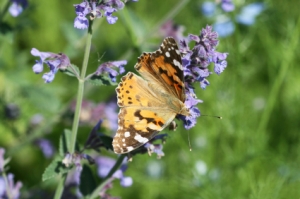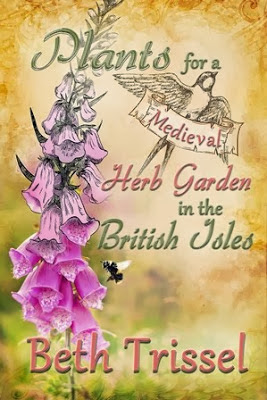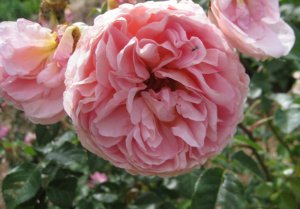 CATNIP: I like catnip. We’ve grown it for years whether intentionally or not. It comes back freely. Yes, our cats like it but not to the point of ecstasy. It’s a member of the mint family but has a distinctively different scent. A hardy, upright, perennial, it has sturdy stems bearing hairy, heart-shaped, grayish-green leaves. The flowers are white or lilac and occur in several clusters toward the tips of the branches. Catnip is a native of Eurasia, naturalized in North America so that it seems as if it’s always grown here.
CATNIP: I like catnip. We’ve grown it for years whether intentionally or not. It comes back freely. Yes, our cats like it but not to the point of ecstasy. It’s a member of the mint family but has a distinctively different scent. A hardy, upright, perennial, it has sturdy stems bearing hairy, heart-shaped, grayish-green leaves. The flowers are white or lilac and occur in several clusters toward the tips of the branches. Catnip is a native of Eurasia, naturalized in North America so that it seems as if it’s always grown here.
From A Modern Herbal:
Catmint: Nepeta cataria, Catmint or Catnep, a wild English plant belonging to the large family Labiatae, of which the Mints and Deadnettles are also members, is generally distributed throughout the central and the southern counties of England, in hedgerows, borders of fields, and on dry banks and waste ground, especially in chalky and gravelly soil. It is less common in the north, very local in Scotland and rare in Ireland, but of frequent occurrence in the whole of Europe and temperate Asia, and also common in North America, where originally. However, it was an introduced species.
 History: The plant has an aromatic, characteristic odour, which bears a certain resemblance to that of both Mint and Pennyroyal. It is owing to this scent that it has a strange fascination for cats, who will destroy any plant of it that may happen to be bruised. There is an old saying about this plant:
History: The plant has an aromatic, characteristic odour, which bears a certain resemblance to that of both Mint and Pennyroyal. It is owing to this scent that it has a strange fascination for cats, who will destroy any plant of it that may happen to be bruised. There is an old saying about this plant:
‘If you set it, the cats will eat it,
If you sow it, the cats don’t know it.’
And it seems to be a fact that plants transplanted are always destroyed by cats unless protected, but they never meddle with the plants raised from seed, being only attracted to it when it is in a withering state, or when the peculiar scent of the plant is excited by being bruised in gathering or transplanting.
In France the leaves and young shoots are used for seasoning, and it is regularly grown amongst kitchen herbs for the purpose. Both there and in this country, it has an old reputation for its value as a medicinal herb. Miss Bardswell, in The Herb Garden, writes of Catmint:
‘Before the use of tea from China, our English peasantry were in the habit of brewing Catmint Tea, which they said was quite as pleasant and a good deal more wholesome. Ellen Montgomery in The Wide, Wide World made Catmint Tea for Miss Fortune when she was ill. It is stimulating. The root when chewed is said to make the most gentle person fierce and quarrelsome, and there is a legend of a certain hangman who could never screw up his courage to the point of hanging anybody till he had partaken of it. Rats dislike the plant particularly, and will not approach it even when driven by hunger.’
This dislike of rats for Catmint might well be utilized by growing it round other valuable crops as a protective screen.
 Medicinal Action and Uses: Carminative, tonic, diaphoretic, refrigerant and slightly emmenagogue, specially antispasmodic, and mildly stimulating.
Medicinal Action and Uses: Carminative, tonic, diaphoretic, refrigerant and slightly emmenagogue, specially antispasmodic, and mildly stimulating.
Producing free perspiration, it is very useful in colds. Catnep Tea is a valuable drink in every case of fever, because of its action in inducing sleep and producing perspiration without increasing the heat of the system. It is good in restlessness, colic, insanity and nervousness, and is used as a mild nervine for children, one of its chief uses being, indeed, in the treatment of children’s ailments. The infusion of 1 OZ. to a pint of boiling water may be taken by adults in doses of 2 tablespoonsful, by children in 2 or 3 teaspoonsful frequently, to relieve pain and flatulence. An injection of Catnep Tea is also used for colicky pains.
The herb should always be infused, boiling will spoil it. Its qualities are somewhat volatile, hence when made it should be covered up.
The tea may be drunk freely, but if taken in very large doses when warm, it frequently acts as an emetic.
 It has proved efficacious in nervous headaches and as an emmenagogue, though for the latter purpose, it is preferable to use Catnep, not as a warm tea, but to express the juice of the green herb and take it in tablespoonful doses, three times a day.
It has proved efficacious in nervous headaches and as an emmenagogue, though for the latter purpose, it is preferable to use Catnep, not as a warm tea, but to express the juice of the green herb and take it in tablespoonful doses, three times a day.
An injection of the tea also relieves headache and hysteria, by its immediate action upon the sacral plexus. The young tops, made into a conserve, have been found serviceable for nightmare.
Catnep may be combined with other agents of a more decidedly diaphoretic nature. Equal parts of warm Catnep tea and Saffron are excellent in scarlet-fever and small-pox, as well as colds and hysterics. It will relieve painful swellings when applied in the form of a poultice or fomentation.
 Old writers recommended a decoction of the herb, sweetened with honey for relieving a cough, and Culpepper tells us also that ‘the juice drunk in wine is good for bruises,’ and that ‘the green leaves bruised and made into an ointment is effectual for piles,’ and that ‘the head washed with a decoction taketh away scabs, scurf, etc.’
Old writers recommended a decoction of the herb, sweetened with honey for relieving a cough, and Culpepper tells us also that ‘the juice drunk in wine is good for bruises,’ and that ‘the green leaves bruised and made into an ointment is effectual for piles,’ and that ‘the head washed with a decoction taketh away scabs, scurf, etc.’

























































As a little girl in Pennsylvania, catnip grew freely around some of our out buildings on the farm (Geez…I originally had outhouses…as in pleural, mercy, good thing I saw that goof!! Eeek!). I loved the smell and often talked my mother into making tea with it. With a couple spoons of sugar for my sweet tooth, it was great. I had no clue it had medicinal purposes–and hazards. Your post was very enteresting and enlightning.
LikeLike
Thanks Vonnie. Very interesting memory you shared.
LikeLike
Now I know how to make a cup of catnip tea when I have a headache 🙂
Thank you for sharing this info.
Lotta
LikeLike
Thanks so much, Lotta. 🙂
LikeLike
Beth, I look it up in a French dictionary. Its name is Cataire, also called Herbe-aux-chats, because it attracts cats. Very interesting. I never heard of it before.
LikeLike
Yes, very interesting. Thanks Mona.
LikeLike
Pingback: Catnip, What is It? » The Spice Style
Thanks for sharin..
LikeLike
Pingback: AghadaFind Me A Cure | Find Me A Cure